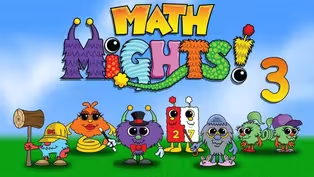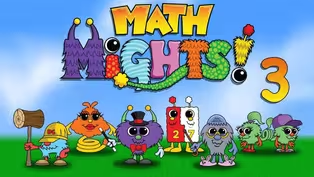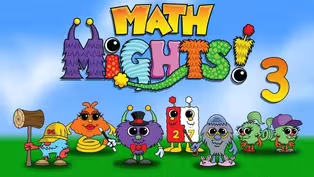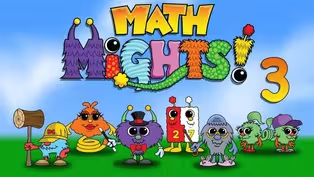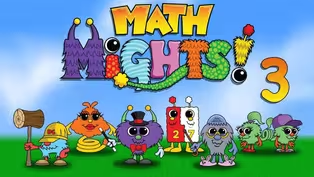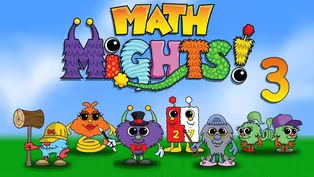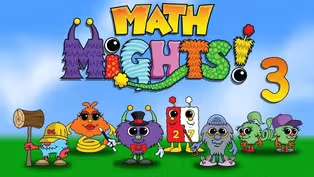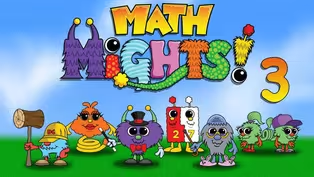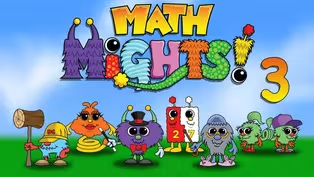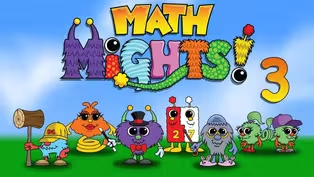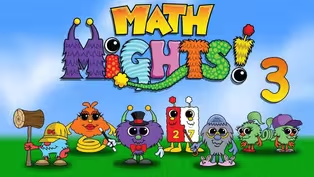Math Mights
Multiply with teen numbers
Season 2 Episode 217 | 16mVideo has Closed Captions
Join Mrs. Askew for a Number Talk with 2 Math Might Friends!
Join Mrs. Askew for a Number Talk with 2 Math Might Friends! Then get ready to have D.C. help us represent multiplication with teen numbers!
Problems playing video? | Closed Captioning Feedback
Problems playing video? | Closed Captioning Feedback
Math Mights is a local public television program presented by Detroit PBS
Math Mights
Multiply with teen numbers
Season 2 Episode 217 | 16mVideo has Closed Captions
Join Mrs. Askew for a Number Talk with 2 Math Might Friends! Then get ready to have D.C. help us represent multiplication with teen numbers!
Problems playing video? | Closed Captioning Feedback
How to Watch Math Mights
Math Mights is available to stream on pbs.org and the free PBS App, available on iPhone, Apple TV, Android TV, Android smartphones, Amazon Fire TV, Amazon Fire Tablet, Roku, Samsung Smart TV, and Vizio.
Providing Support for PBS.org
Learn Moreabout PBS online sponsorshipMore from This Collection
Video has Closed Captions
Join Ms. Askew for a tricky multi-step word problem with Professor Barble! (15m 59s)
Build Fraction from Unit Fractions
Video has Closed Captions
Join Ms. Askew for another multi-step word problem with Professor Barble! (15m 59s)
Video has Closed Captions
Join Ms. Askew for a division word problem with her friend Professor Barble. (15m 59s)
Video has Closed Captions
Join Ms. Askew for a division word problem with her friend Professor Barble. (16m)
Video has Closed Captions
Join Ms. Askew and Professor Barble to do a visual model with a word problem. (15m 59s)
Dividing with even larger numbers
Video has Closed Captions
Join Ms. Askew and Professor Barble to do a visual model with multiplication. (15m 59s)
Video has Closed Captions
Join Ms. Askew and Professor Barble to see if you can match visual models to word problems (15m 59s)
Dividing with Larger Quotients
Video has Closed Captions
Join Ms. Askew and Professor Barble to see if you can match visual models to word problems (15m 59s)
Video has Closed Captions
Learn about multiplying one-digit whole numbers by multiples of 10. (15m 59s)
Video has Closed Captions
Learn about multiplying numbers larger than 20. (16m)
Multiply Teen Numbers with Larger Groups
Video has Closed Captions
Join Mrs. Askew for a Number talk with 2 Math Might Friends! (15m 59s)
Relating Multiplication and Division
Video has Closed Captions
Join Ms. Askew for a subtraction number talk with Springling! (16m)
Providing Support for PBS.org
Learn Moreabout PBS online sponsorship(bright music) - [Children] Math Mights.
- Welcome, third grade Math Mights.
I'm so excited you joined us today.
My name is Ms. Askew, and I can't wait to have fun learning about math with you today.
Let's take a look at our plan for today.
First, we're going to do a subtraction number talk with some of our Math Might friends.
After our number talk, we're going to learn how to multiply with teen numbers.
Let's warm up our brains with a number talk.
When you do a number talk, there are steps that you need to take.
Let's take a look at those steps.
First, you want to pose a problem and use an operation that you're familiar with.
The second step is to try to solve the problem mentally.
And what that means is you want to take that problem and solve it inside your head without using any paper or a pencil.
The third step is to share out how you solved the problem.
When you share out your strategies, you're actually helping other people to find different ways to solve the exact same problem.
Let's see which Math Might friends will be helping us today.
It looks like we have our friends Springling and D.C.
Remember Springling?
She likes to take friendly number hops on an open number line.
Our friend D.C. carries a mallet so he can decompose numbers and regroup them.
Let's look at our problem for today.
86 minus 48.
Let's think about that.
What is a way that you would solve that problem?
Remember, we're going to do it mentally, so no paper or pencil.
Let's see how Lilly used Springling to help her solve the problem.
It looks like Lilly started at the number 48 and she took a friendly number hop to the number 50.
Let's take a closer look at how Lilly used Springling to hop on an open number line.
Lilly started at 48 and stopped at 86.
Lilly wanted to hop to a friendly multiple of 10, which was 50.
What is the distance from 48 to 50?
Springling, can you help us with that?
Hop, Springling, hop.
It's two.
Now that Lilly is at 50, she wants to take another friendly hop on the number line.
So she's gonna start at 50 and hop all the way to the number 80.
Springling, can you help us with that?
How far is it from 50 to 80?
Hop, Springling, hop.
It's 30.
Now, some of you may have hopped a little bit smaller, starting at 50 and hopping to 60 and then to 70 and finally 80, and that's okay too.
But Springling, she likes to take great, big hops.
And that's why she stopped at the number 80.
Now that Lilly is at 80, she wants to stop at 86.
How far is it from 80 to 86?
Help us out, Springling.
Hop, Springling, hop.
It's six.
Now we're going to take those numbers and add them together.
Two plus 30 plus six equals 38.
86 minus 48 equals 38.
Great job, Lilly, using Springling to help solve that subtraction problem on an open number line.
Yoshi agrees with your strategy too, but I think he has a different way of solving it.
I wonder if he's going to use Springling like you did or is he going to use a different Math Might friend?
It looks like Yoshi used our friend D.C. to decompose and rename numbers.
Let's use our whiteboard to take a closer look at how Yoshi used D.C.'s strategy.
Yoshi decomposed the number 86 into 70 and 16.
Now, Yoshi decomposed the number 48 into 40 and eight.
Now it's easier for us to do subtraction.
Take 70 and 40, and let's subtract it.
What do we get?
The number 30.
Now we're going to subtract eight from 16.
That equals eight.
Now we're going to add those two numbers together.
30 plus eight equals 38.
86 minus 48 equals 38.
Great job, Yoshi, using D.C.'s strategy to solve the problem.
But I wonder why you decomposed the number into 70 and 16.
Hmm, wait, I know.
We have a Math Might friend who lives in Mathville and he likes to go around renaming all of the numbers.
His name is T-Pops.
Now, T-Pops is the oldest Math Might friend and Mathville.
He wears glasses, walks with a cane, and he likes to feel comfortable in his bunny slippers.
T-Pops solves problems the traditional way.
Now your parents, they probably can relate to T-Pops because they're kind of old just like him, but don't tell him I said that.
We're going to use our whiteboard to find out how T-Pops solves the problem too.
You can see that I have Yoshi's way of decomposing the numbers.
On the other side, we have T-Pops' strategy.
Now remember, T-Pops likes to rename numbers.
We're going to take the number 86 and we're going to rename that with seven tens and 16 ones.
Now we subtract.
16 ones subtract eight ones leaves us with eight ones.
Seven tens subtract four tens leaves us with three tens.
38 and 38.
Wow, what a great connection we just made with D.C.'s way and T-Pops' way.
Third graders, you are getting so much better at finding new ways and different ways to solve subtraction problems.
Great job.
Let's check out our I can statement for today.
I can make sense of different ways to solve multiplication of teen numbers.
Let's take a look at these three sets of base 10 blocks.
What do you notice?
What do you wonder?
I wonder what you noticed when you looked at that picture.
Let's see what our friends Yoshi and Lilly noticed.
Lilly says, "All of the diagrams have two groups with 12 in each."
Yoshi says, "It is easier to count the 12 in the middle."
I noticed some of those same things too.
Did you?
Let's take a look at what they wonder.
Lilly says, "How could we multiply two groups of 12?"
Yoshi says, "Why are the squares scattered to the left?"
Yoshi and Lilly has some really great wonders.
In the base 10 diagrams, you can see the tens easier.
It's harder to think of tens in the first box.
Multiplying with teen numbers can be a little overwhelming and seem a little scary, but that's what I'm here for, to help break it down and make it easy and fun.
Let's practice with some problems.
Tyler says he can use place value disks to find the value of seven groups of 13 because he knows seven groups of 10 and seven groups of three.
He thinks this diagram proves his thinking.
Do you agree or disagree?
Let's take a closer look at these place value disks to see if we can get a better understanding of what Tyler is saying.
Do you see seven groups of 10?
Do you see seven groups of three?
Using place value disks is a great way to see the seven groups of 10 and the seven groups of three.
I wonder if we can use this strategy to solve the multiplication problem, but I think we need D.C.'s help for this.
Hey D.C. Let's use Tyler's method to find the value of three groups of 14 using D.C.'s help.
D.C. likes to decompose one of the factors to make it easier to solve.
Remember, a factor is a number that you are using to multiply.
D.C.'s going to decompose the factor 14 into 10 and four.
This will make it easier for us to solve the problem.
Let's act it out using the place value disk.
The multiplication problem is three groups of 14.
If we look here, we can see the three groups of 14.
We have 10 and four, which is 14, and there are three groups.
Now we're going to decompose the number 14 to represent our place value disk.
We're going to take 14 and decompose it into 10 and four.
Now we're going to multiply it together to get part of our product.
Three groups of 10, 10, 20, 30, three groups of 10 equals 30.
Now we're going to multiply our three groups of four.
Three groups of four equals 12.
And we can see that looking at our place value disk.
If we count these three groups of four, we see that it equals 12.
Now that we have two different numbers, we're going to add them together.
30 plus 12 equals 42.
If we count all of our disk, it should still equal 42.
10, 20, 30, 31, 32, 33, 34, 35, 36 37, 38, 39, 40, 41, 42.
I really like this strategy.
It helps me to break down multiplication to solve teen numbers.
Let's look at some more ways to solve teen numbers.
Andre, Clare, and Diego represented the same expression.
What do you notice?
What do you wonder?
I don't know about you, but I noticed Clare's picture right away.
She used place value disk, just like we did, but Andre and Diego, they did something different.
Let's look at the problem, four groups of 12 or four times 12.
Remember D.C.?
He likes the decompose numbers and rename them.
D.C. is going to decompose 12 into 10 and two.
Thanks D.C. for decomposing that number and making it easier for us.
Let's act it out on our whiteboard.
We see the problem for groups of 12, and D.C. decomposed the 12 into 10 and two.
Our place value disk represents that.
We can see that we clearly have four groups of 10, one, two, three, four, and four groups of two.
We're going to use the area model to represent those place value disks.
When we draw our area model, we have to make sure that our size boxes represent the value of the number.
We're multiplying by four, and we're going to multiply four groups of 10 and four groups of two.
We want to divide our size box to represent that value.
Four groups of 10 and four groups of two.
Now, I like to put a little multiplication sign up here just to remind myself that I'm going to be multiplying those groups.
If we take four groups of 10, what's the product?
10, 20, 30, 40.
When I multiply four groups of two, what's the product?
Two, four, six, eight.
Our area model demonstrates how we found partial products.
We don't have the complete answer yet because we have to add those two products together.
If we take 40 plus eight, that equals 48.
Four groups of 12 equals 48.
Wasn't it fun using the area model?
Using the area model helps me to organize my multiplication problems so that I can solve them a lot easier.
Let's take a look at how we can solve another problem.
How does this relate to what we're doing with D.C.?
Find the value of five groups of 15 and explain how it's represented in the diagram.
The problem is five groups of 15.
D.C. decomposed that number for us into 10 and five.
When we created on our area model, we want to make sure that the size boxes match the value of our numbers.
We have five groups of 10 equals 50, just like we have five groups of 10 here.
Now we have five groups of five, five groups of five, and that equals 25.
We're going to multiply those numbers together to get our partial products.
Five groups of 10 equals 50.
Five groups of five equals 25.
Now we're going to add those two numbers together.
50 plus 25 equals 75.
Five groups of 15 equals 75.
Now that we've learned how to use the area model with D.C., it's your turn to try four problems of your own.
Make sure you use D.C.'s strategy and decompose those numbers so that you can rename them too and make multiplying with teen numbers easier.
We had a great time with math today.
I hope you join us next time when we learn more about multiplying with bigger numbers.
(bright music) - [Narrator] SIS4teachers.org, changing the way you think about math.
- [Narrator] This program is made possible with funding from the Michigan Department of Education, Governor's Education Emergency Funds, the state of Michigan, and by viewers like you.
(bright music)


- Home and How To

Hit the road in a classic car for a tour through Great Britain with two antiques experts.










Careers that Work

Support for PBS provided by:
Math Mights is a local public television program presented by Detroit PBS
